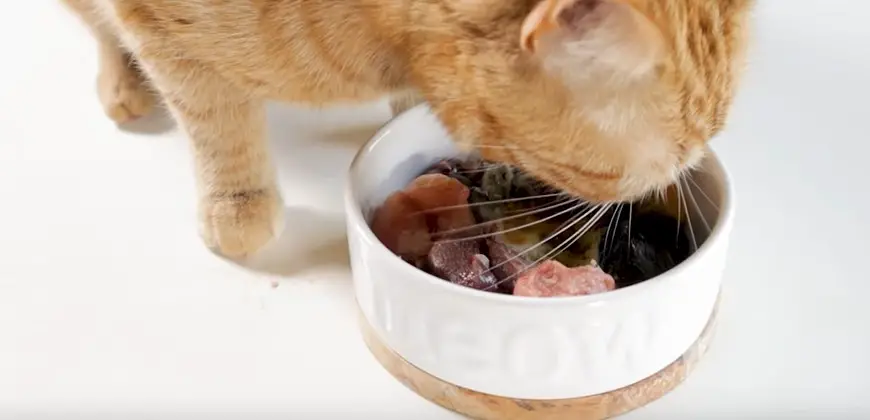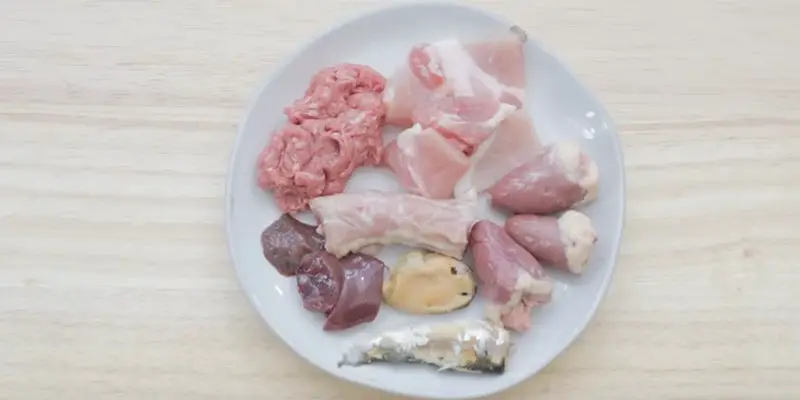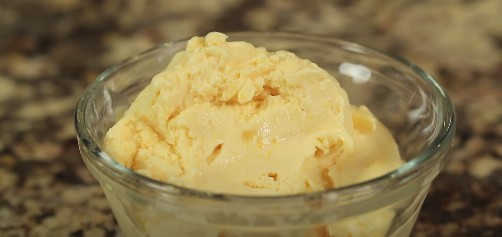Absolutely! While both dogs and cats can benefit from some raw food elements, their recipes diverge considerably. Dogs have stronger digestive systems and less specific nutritional needs, making them more tolerant of raw meat variety.
Cat recipes prioritize taurine-rich organ meats and lean muscle tissues, often finely ground to avoid choking hazards. Think chicken hearts and livers, not big chunks of steak.
Both require careful balancing of nutrients and supplementation by a vet, but cater to each species’ unique dietary demands.
Raw Food Diets for Dogs and Cats
A raw food diet for cats and dogs is growing in popularity and for good reason. Raw food is packed with beneficial vitamins, minerals, enzymes, and fatty acids, which work together to boost your pet’s immune system and support their overall health and wellness.
Proponents of the raw food diet believe that a diet that is as close to what our pets would find and eat in nature is the best for them.

This means feeding them a menu of fresh, uncooked proteins, fats, carbohydrates, fruits, and vegetables. When formulating a raw diet for your pet, you’ll want to consider the following:
- Make sure that the diet you feed is nutritionally balanced.
- Utilize fresh, human-grade ingredients such as meat (from a reputable source) and fresh fruits and vegetables.
- Choose a variety of proteins such as beef, chicken, turkey, lamb, fish, and eggs.
- Introduce new ingredients gradually, so that your pet can get used to the foods you’re feeding.
When it comes to raw food diets for cats and dogs, the main difference is in the protein sources. Dogs are omnivores, which means that they can digest both plants and meats.
Cats, on the other hand, are obligate carnivores; their bodies require a diet high in animal proteins in order to stay healthy.
Because of this, when tailoring a raw food diet for your cat, you’ll want to make sure it contains at least 70% meat-based ingredients, with the remaining 30% being made up of fruits and vegetables.
Read: How Long Do Homemade Cat Food Last?
Benefits of Feeding Raw
Feeding a diet of raw food to your pets has many benefits, including improved digestion, stronger bones and joints, healthier skin and coat, and increased energy levels.
Raw food can help to improve your pet’s digestion because it contains higher levels of enzymes and beneficial bacteria. These enzymes and bacteria help the body process and absorb nutrients more efficiently, which helps to reduce digestive issues.
Raw food is also higher in taurine, an amino acid that cats cannot produce in their bodies. Taurine is especially important for cats, as it helps to regulate heart and eye health. It also helps to reduce inflammation, which is beneficial for cats and dogs that suffer from joint and bone-related conditions.
Raw food also contains higher levels of omega-3 fatty acids, which keep your pet’s skin and coat in top condition. These healthy fats help to keep the skin hydrated and reduce shedding. They also help to nourish the coat, adding shine and volume.

Read: Can Cats Eat Homemade Food?
Creating Raw Food Recipes
With a little planning and creativity, you can easily whip up some tasty meals for your pet. Here are a few tips for creating the perfect raw food recipe for your dog or cat:
- Start with a protein source such as meat, fish, eggs, or organ meats like liver.
- Incorporate one or two vegetables, like broccoli, carrots, or celery.
- Add some healthy fats like olive oil, coconut oil, or fish oil.
- Supplement with a multivitamin or mineral supplement.
When creating your pet’s meals, make sure to use the highest quality ingredients you can find. This means finding organic, hormone-free, antibiotic-free, and non-GMO products whenever possible.
It will also help to invest in a good-quality food processor or blender to make sure your pet’s meals are easily digestible.
The Importance Of A Proper Diet For Cats
A proper diet is of utmost importance for the overall health and well-being of cats. As obligate carnivores, cats have specific dietary requirements that necessitate a diet rich in animal proteins. Protein is crucial for muscle development, maintenance, and overall body function. Additionally, cats require essential amino acids like taurine, which are found abundantly in meat-based diets.
The role of fats in a cat’s diet is equally vital. Fats serve as a concentrated source of energy, aid in the absorption of fat-soluble vitamins, and contribute to healthy skin and coat. Omega-3 and omega-6 fatty acids, derived from quality fats, promote immune function and support cardiovascular health in felines.
Unlike some other animals, cats lack certain enzymes necessary for the efficient breakdown of carbohydrates. Therefore, a cat’s diet should be primarily protein-focused, with minimal carbohydrate content. Commercial cat foods formulated to mimic a cat’s natural diet provide the necessary balance of nutrients.
Proper hydration is another key aspect of feline nutrition. Cats may not have a strong instinct to drink water, making wet cat food an excellent option as it contributes to overall hydration.
A well-rounded, species-appropriate diet supports not only physical health but also mental and emotional well-being. It helps prevent obesity, a common concern in house cats, and minimizes the risk of related health issues such as diabetes and arthritis.
Ultimately, a proper diet tailored to a cat’s unique nutritional needs ensures longevity, vitality, and a higher quality of life. Regular consultation with a veterinarian aids in determining the ideal diet for individual cats, considering factors such as age, weight, health conditions, and lifestyle.
Read: How to Make Homemade Cat Food with Chicken
FAQ’s
Can I Feed My Cat And Dog Raw Chicken?
Tempting as it is to share your vegan vibes with your furry friends, feeding raw chicken to cats and dogs is risky. While it might seem natural, their bodies crave animal protein, but not the bacterial party that comes with raw chicken. Think salmonella and parasites! Consult your vet before any diet changes.
They can suggest safer ways to indulge their inner hunter, without the hospital visits. Trust their expertise, keep your pets safe, and enjoy those happy tail wags and purrs!
Can Dog And Cats Eat The Same Food?
While dogs and cats have distinct dietary needs, there are some pet foods designed for both species. However, it’s essential to note that their nutritional requirements differ significantly. Dogs are omnivores, while cats are obligate carnivores.
Cat food often contains higher protein and fat levels. Feeding dogs and cats the same food may lead to nutrient imbalances, affecting their health. It’s recommended to choose species-specific, nutritionally balanced pet foods to meet the unique dietary needs of dogs and cats.
Can Cats Eat Raw Meat Like Dogs?
Cats and dogs, despite their shared love of chasing squirrels, diverge on raw meat. Dogs can handle it better, thanks to stronger digestive systems. For cats, raw meat carries a higher risk of harmful bacteria and parasites, and they don’t need the same raw protein boost as dogs.
Stick to their usual feline fare, and if you’re curious, consult your vet about safe, cat-friendly raw options. Keep your purring pals healthy and avoid the vet visit blues!
Conclusion
In conclusion, while both dogs and cats can benefit from raw food diets, the recipes should be tailored to each species’ specific nutritional requirements. Dogs are omnivores, allowing for a more varied diet, while cats, obligate carnivores, require higher levels of protein.
Crafting raw food recipes with careful consideration of individual species needs promotes optimal health and well-being for our canine and feline companions.
His professional interests include humane education, ethics, small animal behavior, and veterinary. As a pet lover from school life, having grown up with two cats and a dog. If he isn’t spending time with his friends and family, Justin enjoys traveling. Learn more about Justin here.

